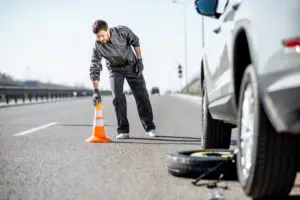What to Do If You Have a Flat Tire on the Highway
A flat tire can quickly turn a routine drive into a stressful situation, especially on a busy road. However, you can handle this common vehicle issue safely and efficiently with knowledge and preparation. Whether you’re a seasoned driver or new to the road, knowing what to do if you have a punctured tire, a tire blowout, or a slow leak on a highway can help you face this unexpected challenge with confidence and ensure you get back on your journey as quickly and safely as possible.
Initial Steps for a Flat Tire: Staying Safe
Dealing with a flat tire can be stressful, especially on a busy road. To ensure your safety, follow these initial steps:
- Find a Safe Location: Grip the steering wheel firmly to counteract the strong vibrations of your flat. Pull over to a safe spot, such as a breakdown lane on the side of the road or a nearby gas station. Avoid stopping in the travel lane or any area that poses a danger.
- Turn on Hazard Lights: Activate your hazard lights immediately to signal other drivers that your vehicle has an issue. This will make you more visible and help prevent accidents.
- Stay Inside the Vehicle: If you’re on a busy highway, it’s crucial to remain inside your vehicle. Exiting can expose you to
 hazards from fast-moving traffic, and staying inside provides protection from potential accidents.
hazards from fast-moving traffic, and staying inside provides protection from potential accidents. - Contact Roadside Assistance: If you have roadside assistance coverage through your insurance or a service like AAA, call them immediately. They can send a professional to help with your flat tire.
- Assess the Traffic: Evaluate the traffic around you. If it’s safe, consider placing warning triangles or flares behind your car to alert approaching drivers. Only do this if you’re sure it won’t put you in danger.
Steps to Change a Flat Tire
Once you’ve taken steps to ensure your safety, you can proceed with changing the tire:
- Activate your emergency flashers to alert other drivers of your situation.
- Set up emergency triangles or cones if you have them, position them behind your vehicle to improve visibility and warn other drivers.
Do I Need Roadside Assistance to Change My Tire?
After securing a safe place, you’ll need to seek assistance:
- Contact Roadside Assistance: If you have a roadside assistance plan through your insurance or a service like AAA, call them for help.
- Call a Tow Truck Company: If you don’t have roadside assistance, contact a tow truck company directly. Provide them with your precise location and details about the situation. Have the tow truck bring your car to an automotive or tire shop.
- Use the Chat Feature: Some roadside assistance services offer a convenient chat feature.
Whether to change the tire yourself or call for help depends on several factors:
- Personal Safety: If you’re on a busy highway or feel unsafe, it’s best to wait for professional help.
- Available Tools: Ensure you have a spare tire, a lug wrench, a jack, and wheel wedges. Without these tools, you’ll need roadside assistance.
- Experience: If you’re unsure about changing the tire, waiting for a tow truck driver or roadside assistance services is safer.
 If you decide to change the tire yourself, gather the following:
If you decide to change the tire yourself, gather the following:
- Spare Tire: Make sure the spare tire is in good condition and properly inflated. These temporary or donut tires are for short trips only. Be sure to get a new tire installed immediately.
- Lug Wrench: This tool, also known as a lug nut wrench, is essential for removing and tightening lug nuts.
- Jack: A jack is needed to lift the car off the ground. Ensure it’s in working order.
- Wheel Wedges: Use wedges to prevent the vehicle from rolling while changing the tire.
- Air Pump: If you have an air pump, check the spare tire’s air pressure to ensure it’s at the recommended level.
What to Do After Changing the Tire
Once you’ve successfully changed the tire:
- Check Tire Pressure: Verify that the spare tire has the correct air pressure using a tire pressure gauge.
- Drive to a Tire Shop: While the spare tire can temporarily get you back on the road, you should drive to the nearest tire shop or repair facility to have the damaged tire repaired or replaced. They can also check the condition of your other tires and provide necessary maintenance.
- Inspect for Other Issues: Use this opportunity to check your vehicle for any additional problems. Look over the remaining tires for signs of wear or damage, ensure all lug nuts are tightened, and inspect the wheel well and suspension components for any issues. Promptly addressing these problems can help prevent further complications.
What to Do If Someone Else Has a Flat Tire on the Highway
If you encounter another driver with a tire puncture or tire blowout:
- Ensure Your Safety: Stop only if it’s safe, and avoid stopping in dangerous conditions.
- Activate Your Hazard Lights: Use your hazard lights to signal other drivers of your presence.
- Offer Assistance: If it’s safe and you’re comfortable, offer to help them change their tire or call for roadside assistance.
- Contact Emergency Services: If the situation seems hazardous or involves an accident, call the police or emergency services.
When a Flat Tire Causes a Car Crash
A sudden flat tire can cause the car to swerve or spin, which may result in collisions with other vehicles or roadside objects. If a flat tire leads to a car accident:
- Check for Injuries: Make sure everyone involved is safe and unharmed.
- Call Emergency Services: Contact the police and, if needed, an ambulance.
- Document the Scene: Take photos of the scene, including tire damage and vehicle positions.
- Notify Your Insurance Company: Inform your insurance provider about the accident to start the claims process.
If You’ve Been Injured in a Car Collision Due to a Defective Tire
 At Munley Law, our car wreck attorneys handle cases involving two major causes of accidents: defective tires and negligent drivers. Tire-related incidents are more common than many realize. According to recent data from the National Highway Safety Administration, there were 562 motor vehicle fatalities due to tire-related crashes in one year alone.
At Munley Law, our car wreck attorneys handle cases involving two major causes of accidents: defective tires and negligent drivers. Tire-related incidents are more common than many realize. According to recent data from the National Highway Safety Administration, there were 562 motor vehicle fatalities due to tire-related crashes in one year alone.
Defective tires can fail without warning, causing a sudden loss of vehicle control. Drivers who neglect proper tire maintenance or drive recklessly are equally dangerous. Our car accident team investigates both scenarios, pinpointing fault among tire manufacturers, negligent drivers, or other responsible parties.
We gather compelling evidence, manage insurance company interactions, and advocate for fair compensation for your injuries. Whether your accident resulted from a tire failure or another driver’s negligence, Munley Law stands ready to assist. Our expertise in tire-related and negligent driving cases ensures we’ll fight effectively for your rights throughout the legal process.
Remember: proper tire maintenance and attentive driving are imperative for road safety. If you’ve been involved in a tire-related or negligent driver accident, contact Munley Law for a free case review.
Posted in Car Accidents.









